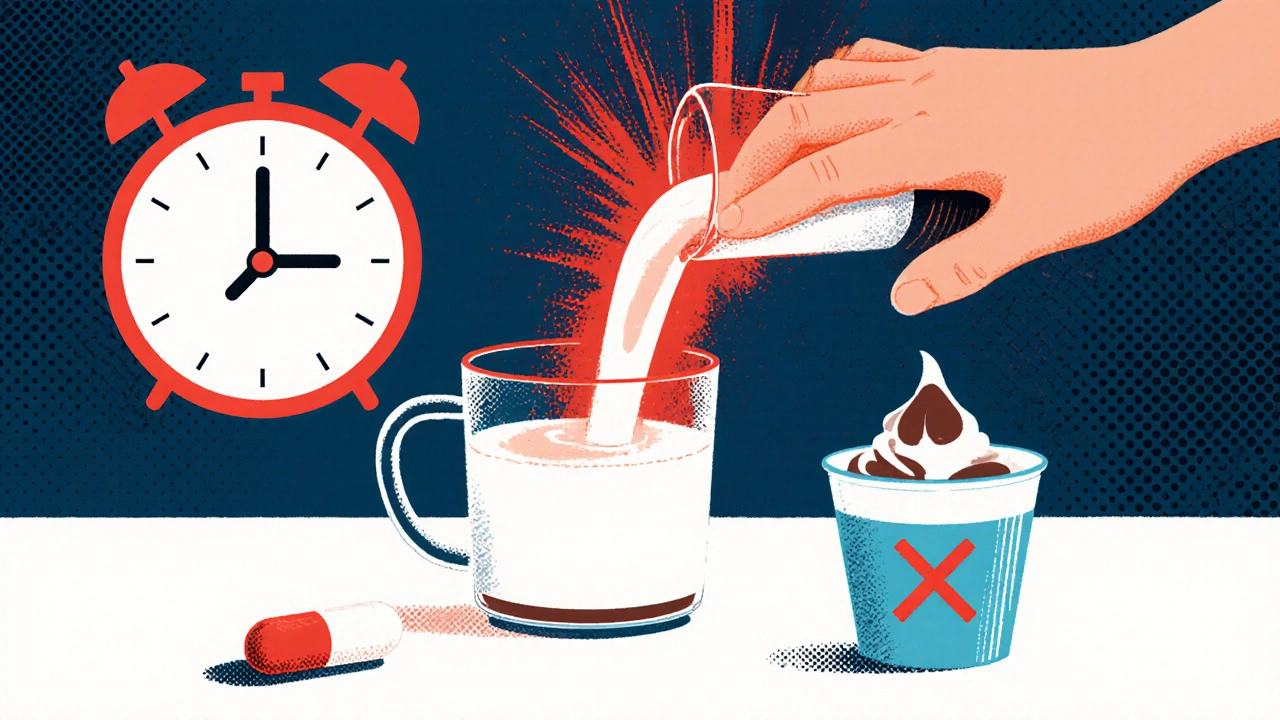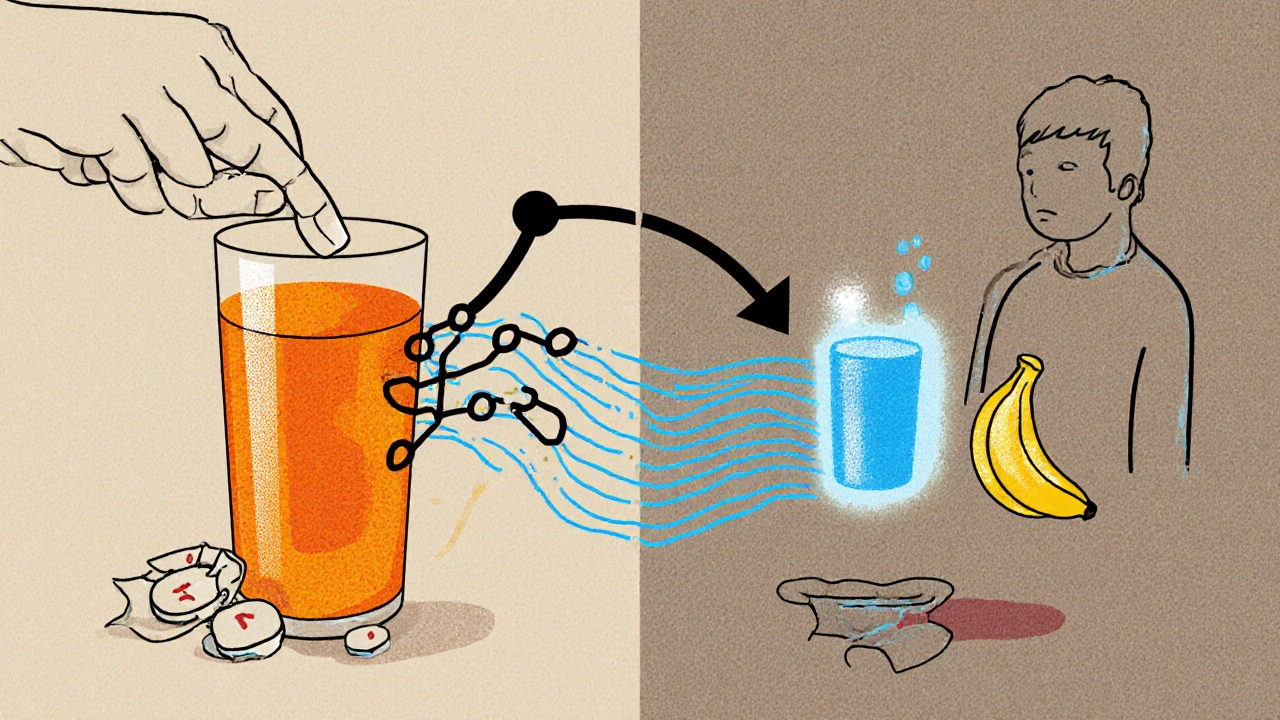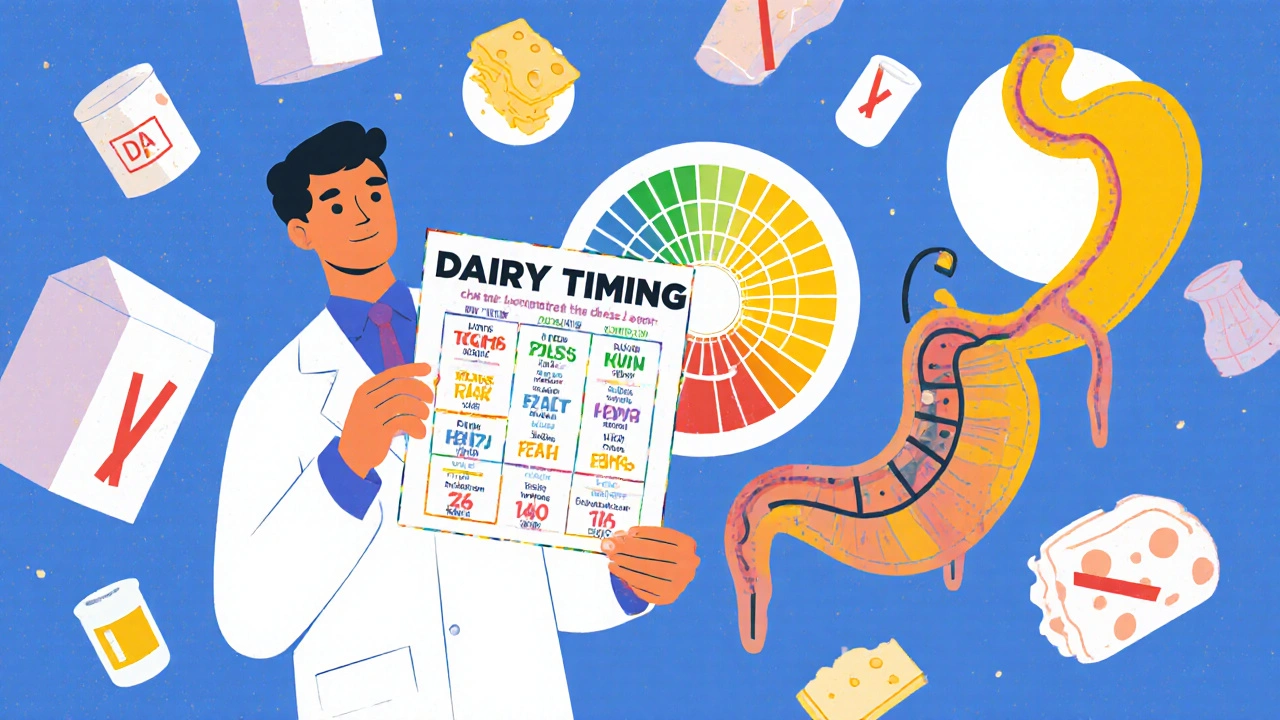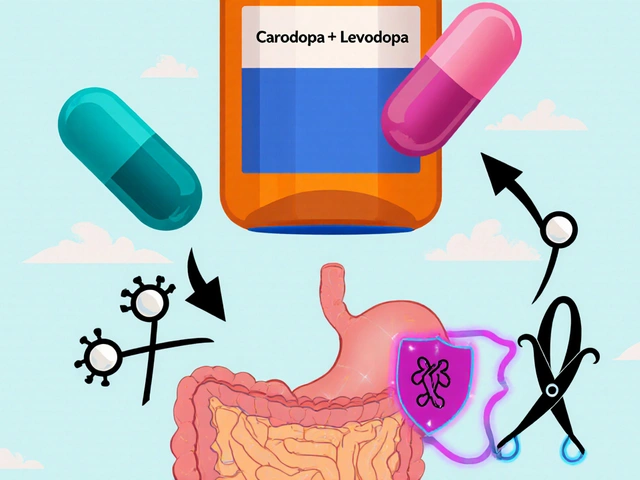
Antibiotic-Dairy Interaction Checker
Check if your antibiotic interacts with dairy products and determine safe timing for consumption.
Select an antibiotic and dairy product to check timing safety.
Many people take antibiotics without realizing that their morning coffee with milk or a yogurt parfait could be ruining the effectiveness of their treatment. It’s not a myth. It’s science. And it’s happening more often than you think.
Why Dairy Interferes with Some Antibiotics
The problem isn’t milk itself-it’s the calcium. When you swallow an antibiotic like tetracycline, doxycycline, or ciprofloxacin, calcium ions in dairy products bind to the drug molecules in your stomach and intestines. This creates a hard, insoluble compound that your body can’t absorb. Think of it like a lock and key: the antibiotic is the key, and calcium is the glue that jams the lock.
Studies show this can cut absorption by as much as 92%. For example, if you take ciprofloxacin with yogurt, only about 8% of the drug makes it into your bloodstream. That’s not just a small drop-it’s a treatment failure waiting to happen. The same thing happens with tetracycline, where milk can reduce absorption by 20% to 75%, depending on how much dairy you’ve eaten.
This isn’t just about convenience. If the drug doesn’t reach the right level in your blood, bacteria don’t die. They survive. And surviving bacteria become resistant. That’s how superbugs form. The World Health Organization estimates over 1.27 million deaths each year are directly linked to antibiotic resistance. Poor timing with dairy is one of the preventable causes.
Which Antibiotics Are Affected?
Not all antibiotics react the same way. Some are barely touched by dairy. Others are completely knocked out.
- High-risk antibiotics: Tetracycline, doxycycline, minocycline, ciprofloxacin, levofloxacin. These are the ones you need to be most careful with. Calcium binds tightly to them, blocking absorption.
- Moderate-risk: Some cephalosporins like cefalexin and cefradine. They show up to 40% less absorption with dairy.
- Low-risk: Amoxicillin, azithromycin, penicillin V. These can usually be taken with food-including dairy-without losing effectiveness.
Even within the same class, differences matter. Doxycycline is less affected than plain tetracycline, and newer versions like sarecycline show much less calcium binding. But if your doctor prescribes doxycycline, don’t assume it’s safe to drink milk with it. Stick to the rules.
How Long Should You Wait?
Timing isn’t optional. It’s medical protocol.
For tetracycline-class antibiotics, you need to wait 2 hours before eating dairy, and 4 hours after. Why the difference? Because tetracycline is absorbed quickly, but the calcium lingering in your gut keeps binding to it for hours. Waiting 4 hours after milk gives your body time to clear the drug before the calcium hits.
Fluoroquinolones like ciprofloxacin need at least 2 hours before or after dairy. That’s shorter, but still critical. One study found that even a glass of milk taken just one hour after ciprofloxacin dropped blood levels by 70%.
Here’s a simple rule: if your antibiotic is on the high-risk list, take it on an empty stomach. No food, no drinks (except water), and definitely no dairy. Wait two hours before breakfast. Wait four hours after dinner. If you’re on a twice-daily schedule, that means your doses might fall at 7 a.m. and 7 p.m.-with no yogurt, cheese, or milk in between.
What Counts as Dairy?
Dairy isn’t just milk. It’s anything that comes from cow’s milk or contains added calcium.
- Milk (whole, skim, 2%)
- Yogurt (even sugar-free or Greek)
- Cheese (cheddar, mozzarella, cottage cheese)
- Ice cream, pudding, whipped cream
- Butter and cream (yes, even a teaspoon in coffee)
- Whey protein powder
- Calcium-fortified orange juice
- Antacids with calcium (Tums, Rolaids)
- Mineral supplements with calcium
People often think almond milk or oat milk is safe. But many brands add calcium carbonate to mimic dairy nutrition. Check the label. If it says “fortified with calcium,” treat it like cow’s milk. Same rule applies.
One pharmacist in Perth told me about a patient who took doxycycline with her almond milk latte every morning. She kept getting sick. Turned out, her “dairy-free” latte had 300 mg of calcium-more than a glass of cow’s milk.

What If You Can’t Take It on an Empty Stomach?
Some antibiotics cause nausea, vomiting, or stomach upset. That’s why people reach for milk or toast. But if you’re on tetracycline or ciprofloxacin, that’s dangerous.
There are two real solutions:
- Take the antibiotic with a small, non-dairy, non-calcium snack-like plain toast, rice cakes, or a banana.
- Switch to a formulation designed to be taken with food. Doxycycline monohydrate (brand name Oracea) is one example. It’s specially made so calcium doesn’t interfere as much. But don’t assume your prescription is this version unless your doctor confirms it.
Don’t just guess. Ask your pharmacist: “Is this version of doxycycline safe with food?” If they say yes, then you can adjust your routine. If not, stick to the timing.
What About Lactose Intolerance?
Some people assume that because they can’t digest lactose, they don’t absorb calcium well. That’s not true. Lactose intolerance affects digestion, not mineral absorption. You still absorb calcium from dairy-even if you get bloated or gassy.
In fact, studies show lactose-intolerant patients on tetracycline still experience the same absorption drop as everyone else. Their bodies still pull calcium from milk and bind it to the antibiotic. The only advantage? They might avoid dairy altogether-which accidentally helps their antibiotic work better.
Real-Life Consequences
This isn’t theoretical. People get sicker because of it.
A 2021 study in the Journal of Antimicrobial Chemotherapy found that 15-20% of tetracycline treatment failures were linked to dairy consumption. That’s tens of thousands of cases every year in the U.S. alone. Each failure means a return visit, a new prescription, maybe even hospitalization.
One patient in a Drugs.com review wrote: “I took doxycycline with my coffee and milk. By day three, my rash got worse. My doctor said I didn’t take it right. I didn’t know dairy was the problem.”
Another common scenario: someone takes antibiotics for a sinus infection, feels better after two days, and stops early-because they think the drug didn’t work. But it did. They just didn’t get enough of it.

How to Avoid Mistakes
Here’s what actually works:
- Write it down. When you pick up your prescription, ask the pharmacist to write the timing on the bottle. “Take 2 hours before or 4 hours after dairy.”
- Use alarms. Set phone alerts for your dose times. If you take it at 7 a.m., set another for 11 a.m. to remind you dairy is safe again.
- Check labels. If you’re unsure if something has calcium, read the nutrition facts. If it says “calcium” or “fortified,” avoid it.
- Ask before you eat. If you’re eating out, ask: “Does this dish have cheese, milk, or yogurt in it?” Even sauces can contain dairy.
- Don’t assume. Just because your friend took amoxicillin with yogurt doesn’t mean your doxycycline is the same.
Electronic health records now flag these interactions, but only if your doctor enters them correctly. Don’t rely on tech alone. You’re your own best safety net.
What’s Changing in the Future?
Pharmaceutical companies are working on new versions of antibiotics that don’t bind to calcium. Sarecycline and eravacycline show promise, with less than 10% absorption loss even with dairy. But these are still new, expensive, and not widely used yet.
The bigger shift is education. In 2023, 89% of major U.S. pharmacies started handing out visual “timing wheels” at the counter-color-coded charts showing when it’s safe to eat dairy after taking your pill. That’s progress.
But until all antibiotics are calcium-proof, timing still matters. A lot.
Bottom Line
If you’re on tetracycline, doxycycline, or a fluoroquinolone, dairy isn’t just something to avoid-it’s a threat to your treatment. Two hours before. Four hours after. Water only. No exceptions.
It’s not about being perfect. It’s about being smart enough to protect your health. One mistake can mean your infection doesn’t clear. That’s not just inconvenient-it’s dangerous.
Ask your pharmacist. Write it down. Set the alarm. Your body-and the bacteria-will thank you.
Can I drink coffee with milk while taking doxycycline?
No. Even a splash of milk in your coffee can block up to 50% of the doxycycline from being absorbed. Wait at least 2 hours after taking the pill before drinking coffee with milk. If you need coffee, have it black, or use a non-calcium-fortified plant milk like unsweetened almond milk (check the label).
Is yogurt safe with antibiotics?
No, not if you’re taking tetracycline or ciprofloxacin. Yogurt has more calcium than milk and a lower pH, which makes the binding even stronger. Studies show yogurt can reduce ciprofloxacin absorption by up to 92%. Wait at least 4 hours after taking your antibiotic before eating yogurt.
Can I take antibiotics with calcium-fortified orange juice?
No. Calcium-fortified juices have the same problem as dairy. They contain added calcium carbonate or citrate, which binds to antibiotics just like milk does. Treat them the same way: avoid for 2 to 4 hours around your dose.
What if I accidentally take my antibiotic with milk?
Don’t panic. Don’t double the next dose. Just skip that dose and wait until your next scheduled time to take the next one. Taking more won’t fix the absorption problem-it could cause side effects. Tell your doctor if this happens often, especially if your infection isn’t improving.
Are there antibiotics that are safe with dairy?
Yes. Amoxicillin, azithromycin, penicillin V, and most cephalosporins (except cefalexin and cefradine) are not significantly affected by dairy. You can take them with food, including milk or yogurt. But always check with your pharmacist-never assume.




Joe Durham
November 20, 2025 AT 09:08I had no idea dairy could mess with antibiotics like this. I used to take my doxycycline with my morning yogurt smoothie-guess that’s why I kept getting sick. Learned the hard way. Now I take it with water, wait two hours, then go nuts with the cheese toast. My infection cleared the second time around. Small change, huge difference.
Thanks for the clarity.
Steve and Charlie Maidment
November 20, 2025 AT 09:21Look, I get it, science says calcium binds to antibiotics, but come on-how many people actually follow this? I’ve seen people take tetracycline with a latte and still recover just fine. Maybe the body’s smarter than we think. Maybe the 92% absorption drop is just lab numbers that don’t reflect real life. I mean, we’ve been eating cheese with pills for decades and the world hasn’t collapsed. Maybe this is just pharmaceutical fear-mongering dressed up as ‘science.’
And don’t even get me started on the ‘set alarms’ advice. Who has time for that? I’ve got a job, kids, and a dog that thinks my ankle is a chew toy. I don’t need a pharmacist micromanaging my breakfast.
Michael Petesch
November 22, 2025 AT 06:11This is an exceptionally well-researched and clinically significant post. The distinction between calcium-binding antibiotics and those unaffected by dairy is critical for patient outcomes, particularly in the context of rising antimicrobial resistance. The data cited-from the Journal of Antimicrobial Chemotherapy to WHO mortality estimates-underscores the public health imperative of patient education.
It is also noteworthy that fortified plant-based milks are now a major confounding variable. Many consumers assume ‘plant-based’ equals ‘safe,’ but the addition of calcium carbonate renders them pharmacologically equivalent to dairy. This is a gap in public health literacy that deserves targeted intervention.
Furthermore, the distinction between doxycycline monohydrate and other formulations highlights the importance of pharmacokinetic nuance in prescribing. Clinicians must be as precise in their counseling as they are in their prescriptions.
Ellen Calnan
November 24, 2025 AT 03:41I cried reading this. Not because I’m dramatic-though I am-but because I remember taking cipro with my ‘healthy’ almond milk latte every morning for three weeks. My UTI came back worse. I thought I was being good to myself. I thought I was ‘clean eating.’ Turns out I was feeding the bacteria.
And then there’s the guilt. The shame. ‘Why didn’t anyone tell me?’
So thank you. Not just for the science, but for the compassion in the way you wrote this. You didn’t shame people who messed up. You gave them a way out. I’m telling my sister. I’m telling my book club. I’m printing this out and taping it to my fridge. This isn’t just medical advice-it’s a lifeline.
Richard Risemberg
November 24, 2025 AT 08:24Man, this is the kind of post that makes you want to high-five your pharmacist. I used to think antibiotics were like energy drinks-just pop it, chug some milk, and boom, you’re good. Nope. Turns out my body’s not a blender.
Here’s the kicker: I took tetracycline with a whey protein shake after the gym. Thought I was being healthy. Turned out I was basically giving my infection a VIP pass to party in my bloodstream.
Now I’ve got a little calendar on my phone: ‘Dose at 7 a.m. - No dairy until 11 a.m.’ I even switched to black coffee. It’s weird at first, but now I kinda like it. Tastes like rebellion.
And yeah, I checked my oat milk. Fortified with calcium? Yeah. Now it’s just ‘oat water.’
Andrew Montandon
November 25, 2025 AT 02:50Wait-so if I take amoxicillin with yogurt, I’m fine? But if I take cipro with yogurt, I’m basically helping the bacteria win? That’s wild. And I thought all antibiotics were the same! Why doesn’t the label say this? Why doesn’t the pharmacist yell it? Why is this not on the pill bottle like ‘WARNING: DO NOT MIX WITH LACTOSE’?
Also, can I take it with almond milk if it’s NOT fortified? What if it’s just plain, unsweetened, no calcium added? Does that count as ‘safe’? Or do I need to read the ingredients like I’m decoding a spy message?
And-this is important-what about calcium supplements? If I take a Tums with my cipro, am I basically giving my infection a free vacation?
Okay, I’m done. But seriously-this needs to be a public service announcement. Like, on TV. With a dog. And a guy in a lab coat pointing at a milk carton.
Sam Reicks
November 25, 2025 AT 07:09Chuck Coffer
November 25, 2025 AT 12:08Wow. Someone actually took the time to write this. How touching.
So let me get this straight-you’re telling me I can’t have my morning yogurt with my antibiotics because of ‘calcium binding’? I’m sorry, but I’ve been doing this for ten years. My body’s fine. My infections clear. The world didn’t end.
And now you want me to set alarms? Write things down? Read labels like I’m preparing for a chemistry final? I’m not a robot. I’m a human who likes his breakfast.
Maybe the real problem is that people are too scared to be sick. Maybe if you just let your body handle it, you wouldn’t need antibiotics at all.
But hey-keep your charts. Keep your alarms. I’ll keep my cheddar.
Marjorie Antoniou
November 26, 2025 AT 21:46This post saved me. I was about to start my next round of doxycycline with my oat milk latte-again. I saw the ‘fortified with calcium’ and thought, ‘it’s plant-based, it’s fine.’ I almost didn’t read the rest.
Thank you for not blaming people. For explaining the why. For giving us practical steps, not just rules. I’m printing this. I’m showing my mom. I’m telling my coworkers.
And yes-I’m switching to black coffee. It’s weird, but it’s my new ritual. I drink it slowly. I breathe. I remember: this isn’t about being perfect. It’s about being smart.
Thank you.